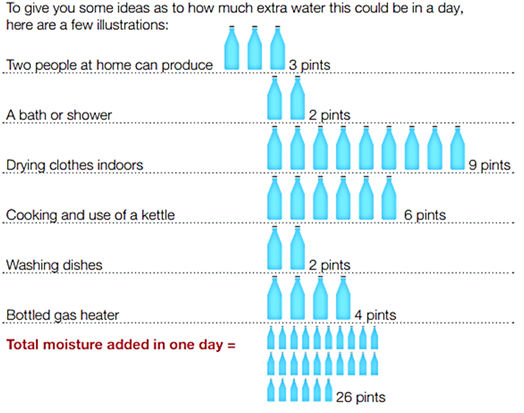Winter Warning!
Condensation and Mould!
Condensation and Mould can be a common problem, even in new property. Condensation is often found as misted up windows or as small pools on window sills. Excessive damp in a house can lead to mould growth and mites which can increase the risk of respiratory illness. The information in this guide will help you to deal with the problem.
What can I do about it?
You can remove any mould by washing down with a bleach type solution or fungicidal wash, and you can buy special paints which may help to prevent the mould coming back. Dry clean mildewed clothes and shampoo affected carpets. Brushing or vacuuming mould affected areas only increases the risk of causing respiratory problems.
The only certain cure is to reduce the amount of moisture produced in your home, and to keep it warm and well ventilated. By doing this, you will stop the condensation forming before it becomes a problem.

Remember…The way you live in your home affects the amount of condensation you get. You won’t need to make drastic changes, just bear these main points in mind:
Doors..
Keep kitchen and bathroom doors shut, particularly if you are cooking, washing or bathing – otherwise water vapour will spread throughout your home and condensation is then likely to occur on external walls and ceilings in colder rooms.
Windows..
The more moisture you produce in your home, the greater your chances of getting condensation and mould – unless you have adequate ventilation. Your house doesn’t need to be draughty but open your windows for a short period when they are misted up. If you are fitting draught stripping, leave a small gap for air to get through. If you have extractor fans in your kitchen or bathroom then use them when you are cooking or having a bath or shower. Ensure that the slot ventilators (if you have them) at the tops of your windows are working and free from any obstruction.
Saucepans and Kettles..
Try not to allow saucepans and kettles to boil any longer than is necessary, and always put the lid on your saucepan.
Heating..
You will get much less condensation if you keep all rooms in your home warm most of the time. It is better to keep an even temperature throughout the day rather than heating your home up from a cold start each time.. 2 hours in the morning and 4 hours in the evening should be a minimum.
If your heating is off for long periods the temperature drops and condensation will form. It may cost a bit more in the short term, but leaving your heating on at a lower level will reduce condensation, damp and the likelihood of mould forming. 18-22°C is the temperature you should aim for as this is room temperature.
Drying Clothes Indoors..
If you are drying clothes, open a window nearby to allow air to circulate, otherwise condensation will increase. If you are using a tumble dryer, it is important that it vents to the outside.
Cupboards and Wardrobes..
Allow free air circulation by not placing wardrobes and furniture too close to the walls. Try not to overfill your cupboards and wardrobes to ensure air can circulate freely within them. You can fit ventilators in the doors, and leave a space at the back of shelves.
The takeaway message is that by simply reducing moisture production where possible and by keeping your house warm and well ventilated, this will reduce condensation and damp, and deny mould the conditions it needs to grow.
Heating Systems
With the onset of the autumn, we strongly recommend that you check your property’s heating system well before the first cold spell. What has happened in the past, is that you only find out about a problem with the heating system e.g. stuck valve or pump etc in that first cold snap.
This then coincides with other people experiencing similar problems, the immediate demand for plumbers and heating engineers is very high, resulting in delays in getting your system repaired.
So, in order that we can ensure your comfort during the cold spell, we would strongly advise that you try the heating system well in advance, i.e. now! This way any problems can be resolved without any inconvenience to you.
Remember, you can report any maintenance issues that you have via your Housing Officer, the Office or Email




